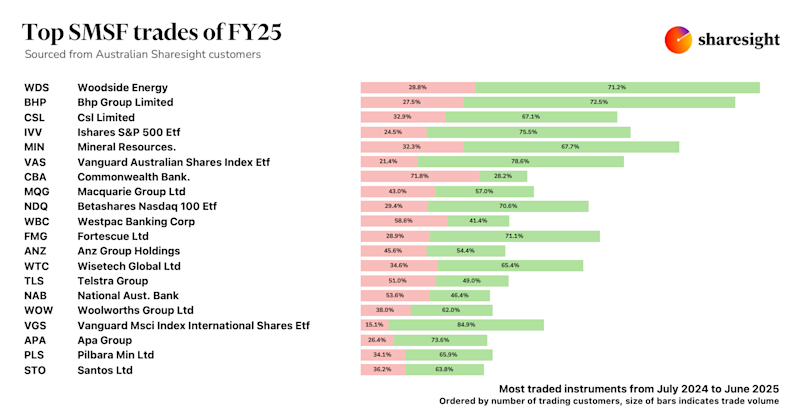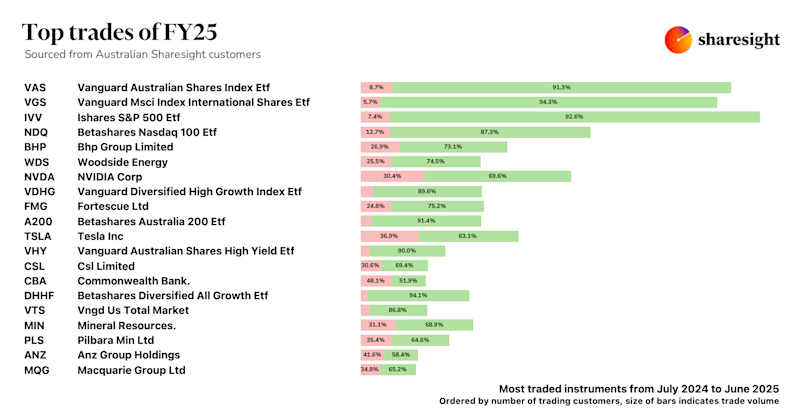COVID-19 volatility puts spotlight on tax-loss selling
Disclaimer: The below article is for informational purposes only and does not constitute a product recommendation, or taxation or financial advice and should not be relied upon as such. Please check with your adviser or accountant to obtain the correct advice for your situation.
Note: A version of this article first appeared on the ASX website.
Tax loss selling (also known as tax loss harvesting) is a strategy some investors leverage to minimise their net capital gains during the financial year with a view to reduce their capital gains tax liabilities.
While investors can choose to sell shares at a loss at any time, it is most often something retail investors look to implement in the lead up to the end of the financial year — and is something we’re expecting to see more of at Sharesight in response to recent COVID-19 market volatility.

What is tax loss selling?
In the broadest sense, tax loss selling involves selling loss-making investments to realise capital losses in order to "net out" capital gains the investor has realised during the year.
Let's look at a hypothetical example to help illustrate how this works:
Let’s say you were lucky enough to buy CSL (ASX: CSL) back in 2012 when it was trading at $32. It’s currently sitting at $305.84, so on paper you’ve seen an annualised return of 33.16%.
However, formerly high-flying Retail Food Group (ASX: RFG), which you bought at $4.00 back in 2014, is now only trading around $0.075 per share after a couple of turbulent years.
| Holding | Purchase Value | Market Value | Capital Gain |
| ASX: CSL | $3,200.00 | $30,557.00 | $27,357.00 |
| ASX: RFG | $4,000.00 | $75 | $-3,925.00 |
Should you think it’s time to take some profits off the table, you could decide to sell some (or all) of your CSL shares, while also exiting your loss-making position in RFG. This would offset some of the gains made — all while softening the psychological blow of realising the loss in RFG.
Notes on tax loss selling
-
In the above example, since CSL has been held for longer than 12 months, it may be eligible for the CGT discount.
-
Although many investors leverage tax loss selling toward the end of the financial year, investors can harvest tax losses at any time in the financial year.
-
Capital losses on shares can in some circumstances be carried forward to offset future capital gains.
-
Modelling tax loss selling opportunities across larger portfolios is best done using a spreadsheet or specific software like Sharesight’s Unrealised Capital Gains Tax Report.
-
Whether you are considered to be holding shares as an investor or a share trader matters to the Australian Tax Office (ATO), as gains for share traders are treated differently.
Avoid wash sales
One thing investors should be very mindful of is the potential to fall afoul of the ATO, in particular tax ruling TR 2008/1, which specifically forbids arrangements where "…in substance there is no significant change in the taxpayer’s economic exposure to, or interest in, the asset, or where that exposure or interest may be reinstated by the taxpayer".
In other words, the ATO does not view kindly investors who sell a stock in one financial year to take advantage of a capital loss event, only to buy that stock again in the new financial year. This is known as a "wash sale" and the ATO will disallow the loss if the sole intention of the sale was to minimise tax.
Investors should always consult their financial advisor or accountant to understand how these rules apply to their individual circumstances.
Why does tax loss selling often occur in June?
For tax purposes, each financial year is used as a snapshot in time to assess the tax payable by individual Australians. Because of this, the timing of when investment income is earned, or when investors realise capital gains/loses is important.
Often this will mean that as investors near the end of the financial year, they look back over their portfolio and assess whether to bring forward the sale of particular investments to realise a capital gain or loss in the current financial year (to offset existing losses or gains), or to hold off a trade to fall in a subsequent financial year.
In fact, some experts believe that many stocks that have fallen during the financial year will slide in early June as investors ‘tidy up’ their portfolios and execute tax loss selling. Further to this point, at Sharesight we always see a surge in the number of investors using our Unrealised Capital Gains Tax Report surge through June as they seek to "lock in" their final portfolio position in the lead up to the June 30 end of the financial year.
Why it could be even more pronounced this year
One word. Volatility.
While ASX returns for the first half of the financial year have been some of the strongest since the GFC, the ASX 200 index is down around 20% for 2020 with some sectors, in particular finance, down about 30% over the same time period.
This volatility has had a sizable impact on the number of trades Sharesight’s Australian users are conducting, with the average number of trades for users on paid Sharesight plans up over 60% in March compared to the same period in 2019.
With investors ramping up their trading activity as they navigate the volatility of markets during the COVID-19 pandemic, we expect this to have implications for how many investors turn to tax loss selling strategies as they attempt to net-out the gains (or losses) realised through this flurry of trading activity.
To get a feel for how widespread this would be in the lead up to the end of the financial year, we asked Sharesight users during May if they intended to sell loss-making investments in their portfolios before June 30 in order to offset gains they had made during the year and found that almost half of respondents (44%) planned to do so.
Looking at the spread of responses by investors we found:
-
22% were very likely to
-
22% were likely to
-
8% were undecided
-
18% considered themselves unlikely to sell down investments
-
31% were very unlikely to
While a lot could change before EOFY, these responses say a lot about investors' willingness to crystallise losses in order to offset gains and place themselves in the best tax position to ensure a fresh start for the next financial year.

Investors need to stay on top of their portfolios
The market volatility caused by COVID-19 has seen many retail investors adopting a more active approach to investing. This includes an increase in trading activity and considering strategies such as tax loss selling.
If this is an approach you’re considering, it’s important to stay mindful of how this trading activity will impact your capital gains tax liabilities come the end of the financial year. Dedicated tools like Sharesight’s Unrealised CGT report can help.
We recommend that you always speak with your financial advisor and/or accountant to get a professional opinion and fully understand how these issues impact your personal financial situation.
Sign up for Sharesight today
Join over 100,000 investors tracking their performance with Sharesight
If you’re not already a Sharesight user, what are you waiting for? It’s free to sign up, and with Sharesight you’ll get access to:
-
Track all your investments in one place, including stocks, mutual/managed funds, property, and even cryptocurrency
-
Get the true picture of your investment performance, including the impact of brokerage fees, dividends, and capital gains with Sharesight’s annualised performance calculation methodology
-
Run powerful reports built for investors, including Performance, Portfolio Diversity, Contribution Analysis and Future Income (upcoming dividends)
-
Run tax reports including Taxable Income (dividends/distributions), Capital Gains Tax (Australia and Canada), Traders Tax (Capital Gains for traders in NZ) and FIF foreign investment fund income reports (NZ)
Sign up for a FREE Sharesight account and get started tracking your investment performance (and tax) today.

FURTHER READING

Sharesight users' top 20 trades – June 2025
Welcome to the June 2025 edition of Sharesight’s monthly trading snapshot, where we look at the top buy and sell trades by Sharesight users in all markets.

Top SMSF trades by Australian Sharesight users in FY24/25
Welcome to our annual Australian financial year trading snapshot for SMSFs, where we dive into this year’s top trades by Sharesight users.

Top trades by Australian Sharesight users in FY24/25
Welcome to the FY24/25 edition of our Australian trading snapshot, where we dive into this financial year’s top trades by Sharesight users.